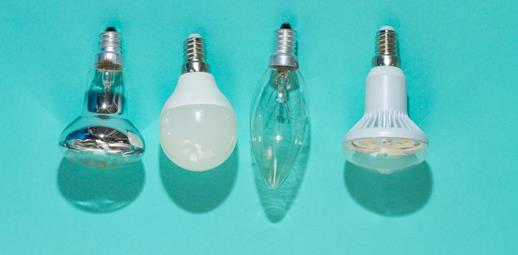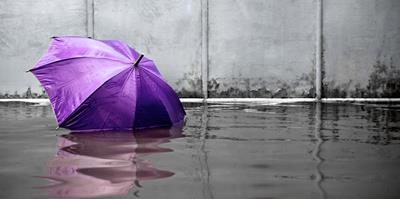
Next time you head to the shops or to your favourite online retailer to replace a light bulb in your home, you may notice things have changed: halogen light bulbs are no longer available.
This is because inefficient bulbs are gradually being phased out in favour of better, greener ones, namely LEDs.
The halogen bulb ban
The September 2021 ban is the latest step in a gradual shift to more energy efficient lighting in the UK and EU.
You may recall when this shift began back in 2009, when traditional or incandescent light bulbs began to be phased out[1]. The traditional bulbs are extremely inefficient, only converting about 5% of the electricity they use into visible light[2].
Then came the start of the end for halogen light bulbs. Like traditional bulbs, these use filaments, but are slightly more efficient. Some of the halogen bulbs were banned from 2018, with the latest rules meaning retailers won’t be allowed to sell almost all remaining halogen bulbs, such as kitchen spotlights[3].
It’s not just halogen bulbs which are under the spotlight. The latest rules also target the sale of lighting fixtures with fixed bulbs that can’t be replaced and have to be thrown away. Fixtures like these account for 100,000 tonnes of electrical waste every year, the government says[4]. It also plans to start phasing out the sale of high-energy fluorescent tube lighting, which is common in offices, from September 2023.
The move to ensure we use more efficient lighting comes as part of a wider package of energy efficiency measures, which also includes the right to repair, new energy labels and higher energy efficiency standards for white goods, TVs and other electrical appliances.
The benefits of LEDs
LED, or light-emitting diode lighting, hasn’t always been popular and was initially criticised for being overly expensive or not powerful enough.
But LEDs now offer comparable or better light quality than traditional bulbs and are getting cheaper all the time.
Part of their appeal is that they’re long-lasting. LED lights last five times longer than traditional halogen lightbulbs and produce the same amount of light – but use up to 80% less power[5].
Lighting accounts for 15% of the average UK household electricity consumption, so switching to LED lights could help you save money too[6]. If you replaced all the bulbs in your home with LED lights, you could cut £30 a year off your electricity bills, according to Energy Saving Trust. (link)
Which bulb to choose?
It’s important to get the correct brightness from your bulb, if you choose a bulb that isn’t bright enough or it illuminates everything in the room when you don’t want it to. The chart below will help you to get it right.
|
Brightness in Lumens |
Traditional |
LED |
CFL bulb |
Halogen |
|---|---|---|---|---|
|
220+ |
25W |
4W |
6W |
18W |
|
400+ |
40W |
6W |
9W |
28W |
|
700+ |
60W |
10W |
12W |
42W |
|
900+ |
75W |
13W |
15W |
53W |
|
1300+ |
100W |
18W |
20W |
70W |
Source: https://www.thelightbulb.co.uk/resources/lumens_watts/
What do the colour codes mean?
If you’ve ever wondered what the coloured bar charts mean on the packaging, this shows the colour rendering index (CRI) of a bulb.
What is CRI? This is how well a bulb will illuminate a chosen colour in a room. Two bulbs can have the same colour, but the bulb with a higher CRI will show certain colours more accurately than the other. To find out more about CRI, see Waveformlighting
Green labels and other ways to reduce your lighting bill
If you’re not sure which light bulbs are the most environmentally friendly, then check out the energy labels on their boxes.
These are being updated, to use a new scale from A-G (doing away with the A+, A++ or A+++ ratings), with A being the greenest option.
In addition to switching to buying the most efficient LEDs, the Energy Saving Trust suggests some other ways to cut your lighting bill:
- Turn lights off whenever you leave a room. This could save the typical household almost £11 a year.
- Consider whether you need different lights on in a room at the same time. You probably don’t need a lamp on as well as the main light.
- Use external lights with sensors or timers, so they’re only on when they need to be
- Avoid dark lampshades and instead consider using transparent shades or fittings to increase the impact of the light. Also, clean them regularly, for the same reason.
For more tips on how to stay happy and safe in your home, go to Solved.
[1] https://www.theguardian.com/environment/2012/aug/31/lightbulbs-incandescent-europe
[2] https://energysavingtrust.org.uk/how-get-best-out-energy-efficient-lighting/
[3] https://www.bbc.co.uk/news/uk-57407233
[4] https://www.gov.uk/government/news/end-of-halogen-light-bulbs-spells-brighter-and-cleaner-future
[5] https://www.gov.uk/government/news/end-of-halogen-light-bulbs-spells-brighter-and-cleaner-future
[6] https://energysavingtrust.org.uk/advice/lighting/


